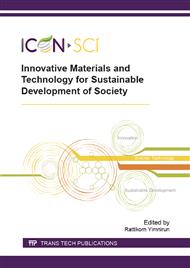p.167
p.171
p.175
p.179
p.183
p.187
p.191
p.195
p.199
The Fabrication of Titanium Dioxide (TiO2) Thin Film via Deposited Spray Pyrolysis Using for Antibacterial Applications
Abstract:
Titanium dioxide (TiO2) is coated onto the materials (e.g. glass ceramic) to inhibit the bacteria growth. TiO2 has become a popular photocatalyst for both air and water purification. It has also shown to be very active for bacterial destruction even under UV light. The photocatalytic of TiO2 involves the light-induced catalysis of reducing and oxidizing reactions on the surface of materials. The spray pyrolysis technique for material synthesis in thin-film configuration is an interesting option due to the use of inexpensive precursor materials and low-cost equipment suitable for large-area coatings. In this research, TiO2 thin films were deposited onto glass substrates using spray pyrolysis technique. Escherichia coli (E.coli) was used as testing bacteria. TiO2 thin films showed some antibacterial effect in the halo test.
Info:
Periodical:
Pages:
183-186
Citation:
Online since:
October 2015
Price:
Сopyright:
© 2015 Trans Tech Publications Ltd. All Rights Reserved
Share:
Citation:


